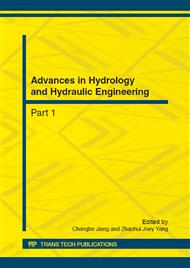p.358
p.362
p.366
p.372
p.377
p.383
p.391
p.395
p.399
Laboratory Study of Unsaturated Flow in a Single Fracture-Matrix System: A Conceptual Model
Abstract:
A conceptual laboratory model for studying unsaturated flow in a single fracture-matrix system is developed in this paper. The model is capable of simulating the fracture and matrix with different samples, and three groups of contrastive experiments are conducted under a constant rainfall. The results show that fracture-matrix interactions have a great effect on the hydraulic properties of the fracture and matrix. The more distinctive the sample used to simulate the fracture and matrix is, the greater the influence is. Furthermore, the wetting front along the matrix runs ahead of that along the fracture, resulting in an extra water source for the fracture. It could be concluded fracture-matrix interactions and unsaturated hydraulic conductivity of the matrix cannot be ignored when the fracture is surrounded by a permeable matrix.
Info:
Periodical:
Pages:
377-382
Citation:
Online since:
October 2012
Authors:
Price:
Сopyright:
© 2012 Trans Tech Publications Ltd. All Rights Reserved
Share:
Citation:


